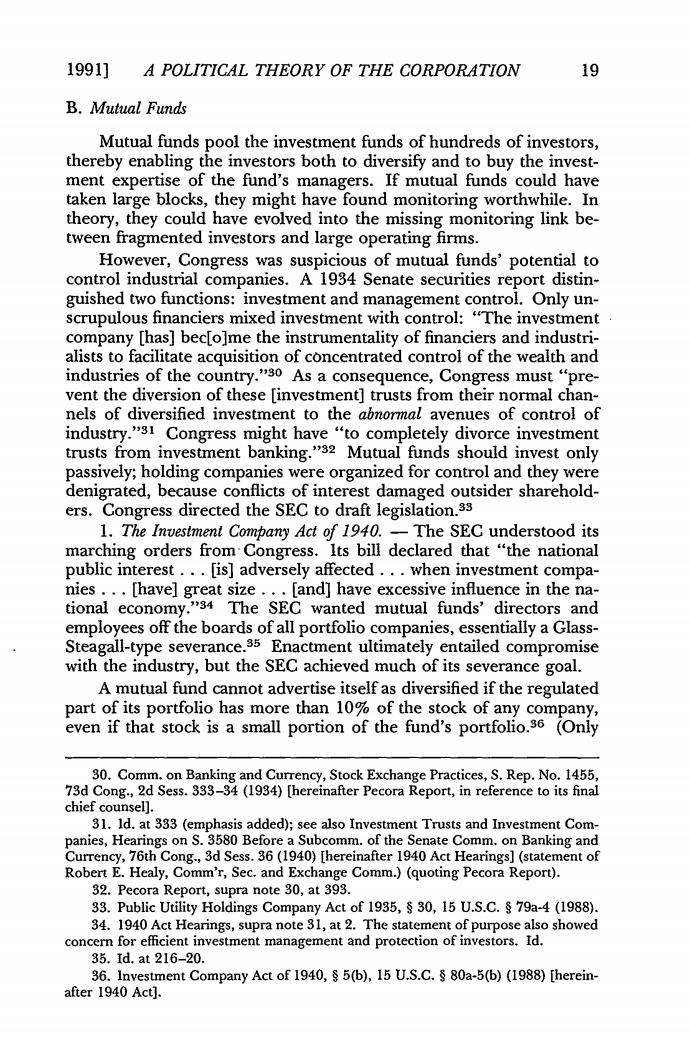正在加载图片...

1991] A POLITICAL THEORY OF THE CORPORATION 19 B.Mutual Funds Mutual funds pool the investment funds of hundreds of investors, thereby enabling the investors both to diversify and to buy the invest- ment expertise of the fund's managers.If mutual funds could have taken la rge blocks,they mi ave nitoring worthwhile theory,they could have evolved into the missing monitoring link be- tween fragmented investors and large operating firms. However,Congress was suspicious of mutual funds'potential to control industrial companies.A 1934 Senate securities repor t distin guished two functions:investment and management control Only un- scrupulous financiers mixed investment with control: “The investment company [has]bec[o]me the instrumentality of financiers and industri- alists to facilitate acquisition of concentrated control of the wealth and industries of the "30 As a cons gres vent the of these [inves trust from their normal chan of diersified investment to the o avenues of cor of Congress might have "to completely divorce investment trusts from investment banking."32 Mutual funds should invest only passively;holding companies were organized for control and they w den gated,becag nflicts of inte ged outsider sha ers Congress directe the SEC to draft legislation. 1.The Investment Company Act of 1940.- -The sEC understood its marching orders from Congress.Its bill declared that "the national public inte [is]adversely affected. when investment compa- e .[have great [and]have exce in the na tional economy. C wanted mutual funds and employees off the boards of all portfolio companies,essentially a Glass- Steagall-type severance.35 Enactment ultimately entailed compromise with the industry,but the SEC achieved much of its severance goal. A mutual fund cannot advertise itself as diversified if the regulated part of its portfolio has more than 10%of the stock of any company, even if that stock is a small portion of the fund's portfolio.36 (Only 30.Co Stock Excha C D 73d c ort,in reference to its final chief counsell. 31.ld.at 333(emphasis added);see also Investment Trusts and Investment Com- 30 Betore ong3d Sess.6(1 mm.of the Senate Comm.on Banking and 40)[herei Act F (state nent of 6 (quoting eport). 33.Public Utility 30,at3 gs Co Act of193530,15U.S.C.s79a-4(1988 conce ment and pr 35.1d.at216-20. 36.Investment Company Act of 1940,$5(b),15 U.S.C.80a-5(b)(1988)[herein- after 1940 Act. 1991] A POLITICAL THEORY OF THE CORPORATION 19 B. Mutual Funds Mutual funds pool the investment funds of hundreds of investors, thereby enabling the investors both to diversify and to buy the investment expertise of the fund's managers. If mutual funds could have taken large blocks, they might have found monitoring worthwhile. In theory, they could have evolved into the missing monitoring link between fragmented investors and large operating firms. However, Congress was suspicious of mutual funds' potential to control industrial companies. A 1934 Senate securities report distinguished two functions: investment and management control. Only unscrupulous financiers mixed investment with control: "The investment company [has] bec[o]me the instrumentality of financiers and industrialists to facilitate acquisition of concentrated control of the wealth and industries of the country."30 As a consequence, Congress must "prevent the diversion of these [investment] trusts from their normal channels of diversified investment to the abnormal avenues of control of industry." 3 ' Congress might have "to completely divorce investment trusts from investment banking."'3 2 Mutual funds should invest only passively; holding companies were organized for control and they were denigrated, because conflicts of interest damaged outsider shareholders. Congress directed the SEC to draft legislation.33 1. The Investment Company Act of 1940. - The SEC understood its marching orders from Congress. Its bill declared that "the national public interest ... [is] adversely affected ... when investment companies ... [have] great size ... [and] have excessive influence in the national economy." 34 The SEC wanted mutual funds' directors and employees off the boards of all portfolio companies, essentially a GlassSteagall-type severance.3 5 Enactment ultimately entailed compromise with the industry, but the SEC achieved much of its severance goal. A mutual fund cannot advertise itself as diversified if the regulated part of its portfolio has more than 10% of the stock of any company, even if that stock is a small portion of the fund's portfolio.36 (Only 30. Comm. on Banking and Currency, Stock Exchange Practices, S. Rep. No. 1455, 73d Cong., 2d Sess. 333-34 (1934) [hereinafter Pecora Report, in reference to its final chief counsel]. 31. Id. at 333 (emphasis added); see also Investment Trusts and Investment Companies, Hearings on S. 3580 Before a Subcomm. of the Senate Comm. on Banking and Currency, 76th Cong., 3d Sess. 36 (1940) [hereinafter 1940 Act Hearings] (statement of Robert E. Healy, Comm'r, Sec. and Exchange Comm.) (quoting Pecora Report). 32. Pecora Report, supra note 30, at 393. 33. Public Utility Holdings Company Act of 1935, § 30, 15 U.S.C. § 79a-4 (1988). 34. 1940 Act Hearings, supra note 31, at 2. The statement of purpose also showed concern for efficient investment management and protection of investors. Id. 35. Id. at 216-20. 36. Investment Company Act of 1940, § 5(b), 15 U.S.C. § 80a-5(b) (1988) [hereinafter 1940 Act]